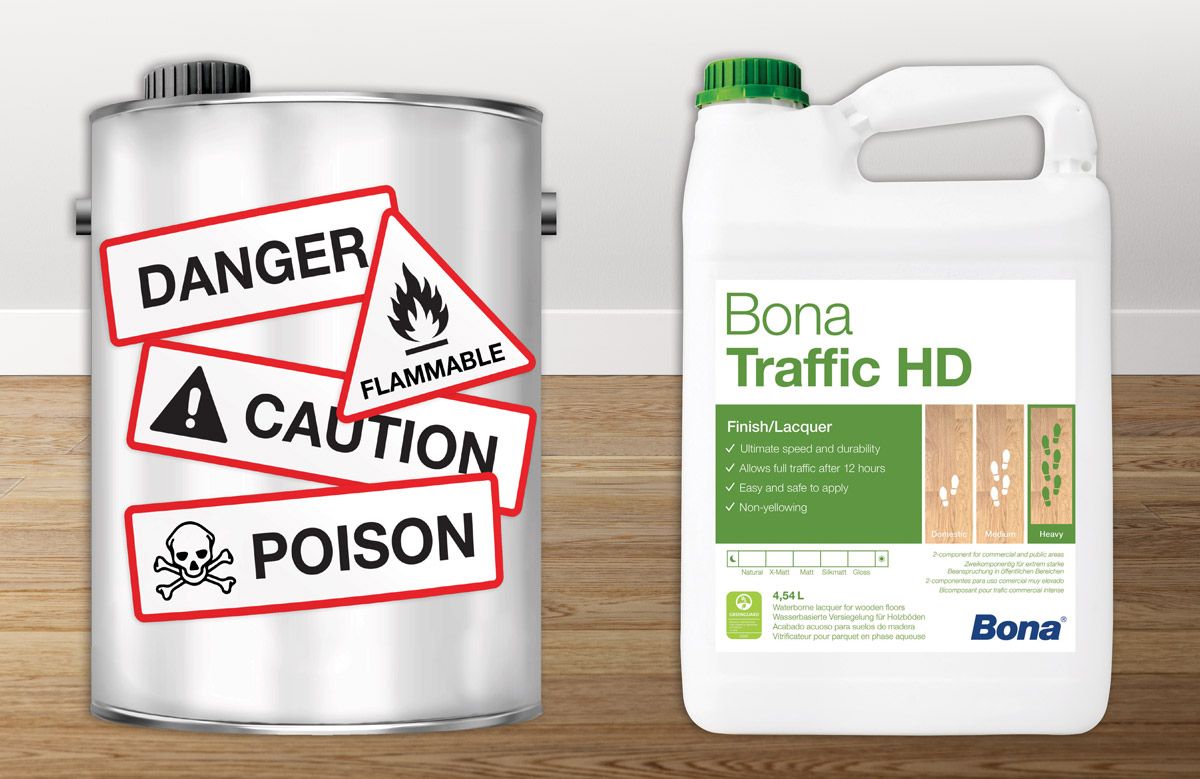Solvent vs Water-based Floor Finishes
Choosing a non-toxic water-based timber floor finish protects you & your family’s health.
- Home
- Home Owners
- FAQ
- Solvent vs Water-Based
What are the health risks of solvent-based finishes?
Some of the serious health effects from short and long-term exposure to solvents include:
- • Chronic and Acute Asthma
- • Memory Loss, Brain Damage
- • Clinical Depression, Aggressive Behaviour
- • Impaired Fertility, Birth Defects, Neurocognitive Development
- • Sleep Apnea
- • Peripheral Nerve Conditions
- • Increased Susceptibility to Cancers
What is a solvent-based finish?
Solvent-based polyurethane finishes were the standard choice for coating timber floors back in the 1950’s. The technology is based on chemical
formulas which use solvents as the carriers for the polyurethane. Solvent finishes are now classified as poisons posing serious health risks. Water-based finishes are now accepted as superior and pose no health threats.
What is a water-based finish?
Water-based floor finishes use water as the carrier for polyurethane dispersion. They are classified as non-toxic, produce no toxic fumes and contain no harmful chemicals. The technology of water-based finishes provides equal or better wear resistance to solvent-based and better retains the natural colour of timber. The amount of Volatile Organic Compounds (VOC’s) which are emitted as gases during the curing process of the coating. VOC gases are toxic and flammable. Solvent coatings release high levels of VOC’s posing
serious health risks, with off-gassing continuing up to months after
application. Water-based finishes emit such a low level of VOC’s they
are considered harmless.
What are Volatile Organic Compounds (VOC's) are they dangerous?
Volatile Organic Compounds (VOC’s) are the gases emitted during the curing process of the floor coating. VOC gases are toxic and highly flammable. Solvent coatings release high levels of VOC’s posing
serious health risks, with off-gassing continuing up to months after
application. Water-based finishes emit such a low level of VOC’s they
are considered harmless.
Most Bona finishes are below 80 grams per litre (g/Lt) VOC and none
exceed 90g/Lt, well below the strict EU standard of 140g/Lt. Solvent
finishes contain toxic VOC’s of between 300-850g/Lt.
What are the regulations for use in Australia?
Regulations in Europe now ban the use of Solvent based timber floor finishes. The European Union (EU) strictly controls VOC levels in building supplies, and hence solvent based finishes are illegal to use.
In Australia however, there is no such legislation in place. Solvents can still be used by contractors with no health warnings required to protect or warn home owners. Consumers need to be well informed when choosing a floor coating to make a choice which protects the health of themselves and their families.
Which type of finish wears better?
The technology of water-based finishes provides equal or better wear
resistance to solvent-based and better retains the natural colour of timber, with no toxic fumes or health risks.
 SOLVENT-BASED
SOLVENT-BASED
![]()
- 300-850g/Lt VOC
- Solvent-based polyurethane
- Toxic hazardous chemicals & Isocyanates
- Classified as a poison
![]()
- Toxic fumes and Isocyanates
- Asthma, Headaches, Nausea, Respiratory irritation
- Impaired fertility, Nervous System Disorders, Insomnia, Depression, Anxiety, Fatigue
- Contaminates foodstuffs in fridge & pantry
- Requires toxic chemicals for clean-up
- Home owners should vacate home for up to 14 days due to toxic fumes off-gassing
![]()
- Plastic unnatural appearance
- Yellows
- Old technology, Designed for yesterday
 WATER-BASED
WATER-BASED
![]()
- 40-90g/Lt VOC
- Water-based polyurethane
- No hazardous chemicals
- No health risk
![]()
- No toxic fumes
- GreenGuard Gold Certified
- No effect on fresh or stored foods
- Easy clean-up in water
- No need to vacate premises, Home owner can remain throughout application
![]()
- Beautiful, natural looking finish
- Non-yellowing
- Hard-wearing protection proven on millions of square metres
 Global
Global Australia
Australia Austria
Austria Belarus
Belarus Belgium (FR)
Belgium (FR) Bulgaria
Bulgaria Canada (EN)
Canada (EN) China ( 中文)
China ( 中文) China Hong Kong
China Hong Kong China Taiwan ( 中文)
China Taiwan ( 中文) Croatia
Croatia Czech Republic & Slovakia
Czech Republic & Slovakia Denmark
Denmark Finland
Finland France
France Germany
Germany Greece
Greece Hungary
Hungary India (EN)
India (EN) Israel
Israel Italy
Italy Japan (日本語)
Japan (日本語) Lithuania
Lithuania Luxemburg (FR)
Luxemburg (FR) Morocco (FR)
Morocco (FR) Netherlands
Netherlands New Zealand
New Zealand Norway
Norway Poland
Poland Portugal
Portugal Romania
Romania Russia
Russia Serbia
Serbia Singapore
Singapore Slovenia
Slovenia South Africa (EN)
South Africa (EN) Spain
Spain Sweden
Sweden Switzerland (DE)
Switzerland (DE) Ukraine
Ukraine United Arab Emirates (EN)
United Arab Emirates (EN) United Kingdom & Ireland
United Kingdom & Ireland United States
United States
